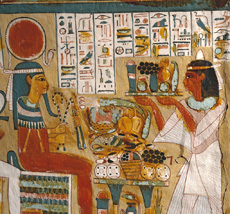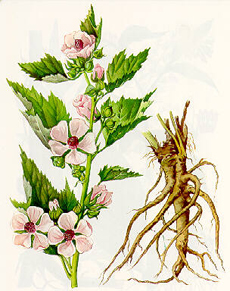

Both the Toasted Coconut and Vanilla Marshmallow Meltaways from Sweet & Sara were among the best we tasted in a field of dozens of brands—and they’re vegan, not made with gelatin like almost all the other marshmallows. Bravo! Photo by Dhanraj Emanuel | THE NIBBLE.
|
STEPHANIE ZONIS is a Contributing Editor.
|
|
November 2007
Updated February 2017
|
 |
Marshmallow Madness
Page 2: Marshmallow History
This is Page 2 of a six-page overview of marshmallows. Click on the black links below to visit other pages.
History Of Marshmallows: A Sticky Past
The marshmallows of today are a far cry from their ancient ancestors.
Marshmallows take their name from the marsh mallow plant (Althea officinalis). The root of the marsh mallow plant produces a sticky, white, almost jelly-like substance.
Supposedly, the Egyptians took advantage of it as early as 2000 B.C.E., combining it with honey to make a candy.
The Greeks, (and, later, Arabs and Indians), used marsh mallow for medicinal purposes, often as an ingredient in preparations to quiet coughs.
According to Tim Richardson in Sweets: A History of Candy, in the medieval era, pieces of marsh mallow root were candied as sweets. By the 1600s, however, they were being prescribed for urinary problems.
The transition to the modern-day marshmallow began with the French; most sources date these early modern marshmallows to around 1850. A concoction of egg whites, water, and sugar or corn syrup, with the sap of the marsh mallow root as a binder, was heated and beaten to a froth.*
Marshmallows were molded individually, in molds dusted with corn starch. As equipment and methods advanced, mass production of marshmallows became possible, and by 1900 they were being sold as penny candy.
Gradually, gelatin replaced the root of the marsh mallow as the binding agent, but the candy still kept the old name. And the use of egg whites in commercially-made marshmallows has largely gone by the wayside, as well.
Today’s marshmallows are made from sugar, corn syrup, gelatin, cornstarch, confectioners’ sugar and flavorings (including salt).
Honey, water and invert sugar may also be used |
|


Top: Egyptians first turned the sap of the marsh mallow root into candy (image courtesy Teaching History 101). Bottom: The marsh mallow plant. |
According to candy maker Sugarcraft, invert sugar combines sugar syrup with a small amount of an acid, such as lemon juice, to break down the sugar into its two components, glucose and fructose (the process is called “inverting”). This inversion reduces the size of sugar crystals and can yield a smoother end-product.
Today there are also sugar-free marshmallows made with maltitol. I have not had them, but according to our editorial director, they’re delicious. (See our review of La Nouba Sugar-Free Marshmallows.)
___________
*Today’s artisan marshmallows use pure cane sugar, water, egg whites, gelatin, corn syrup, pure vanilla extract, salt, flavorings, and, in some flavors, natural or artificial colorings.
Continue To Page 3: Modern Marshmallows
Go To The Article Index Above

|






